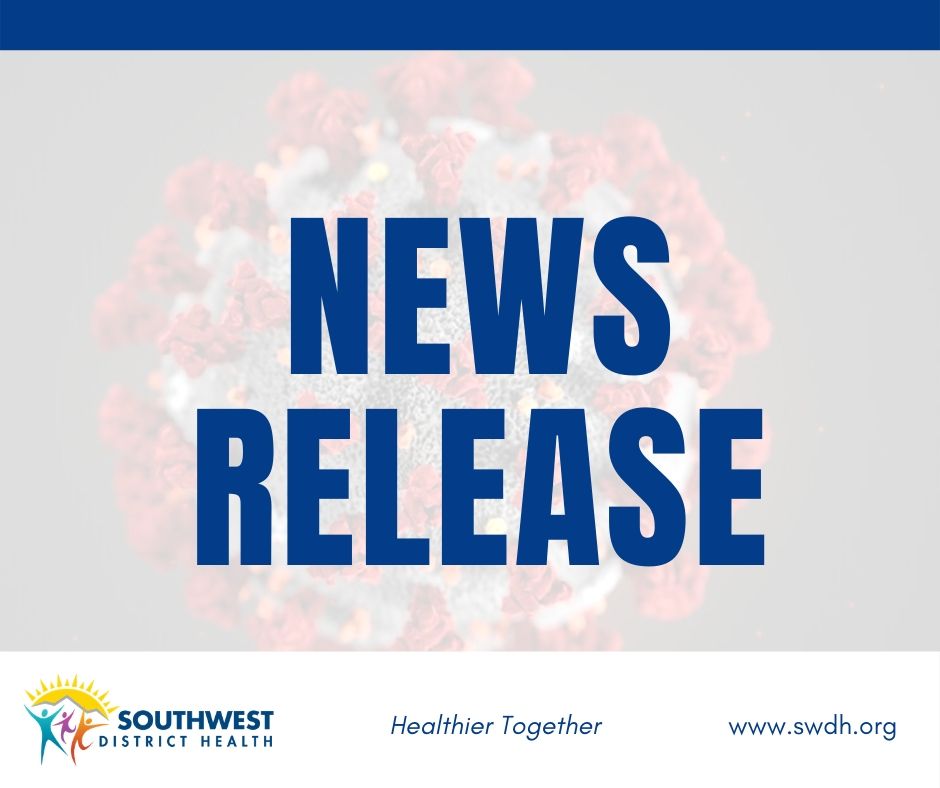FOR IMMEDIATE RELEASE
CALDWELL, IDAHO – Southwest District Health (SWDH) is announcing the first case of monkeypox in its jurisdiction of an Idaho resident. The case was detected in Canyon County.
The investigation is ongoing. Local and state public health officials are working with the patient’s healthcare providers to ensure the patient is treated and any potential close contacts are identified and notified of exposure risk.
Testing for initial identification was performed at the Idaho Bureau of Laboratories, and samples are being sent to CDC for confirmation of the monkeypox virus; results from CDC are expected in the next week.
Monkeypox usually causes a mild illness, and most people recover on their own. Antivirals are available for patients who might have severe disease or develop complications. Southwest District Health recommends vaccination for people who have been exposed to monkeypox to reduce symptoms and prevent further spread in our community. Individuals with monkeypox should self-isolate until their lesions have fully healed with new skin where the lesions used to be.
How is monkeypox spread?
Monkeypox can spread to anyone through close, personal, often skin-to-skin contact, including:
- Direct contact with monkeypox rash, scabs, or body fluids from a person with monkeypox. We believe this is currently the most common way that monkeypox is spreading in the U.S.
- Touching objects, fabrics (clothing, bedding, or towels), and surfaces that have been used by someone with monkeypox.
- Contact with respiratory secretions.
What are the symptoms of monkeypox?
Close contacts should be monitored for symptoms for 21 days after their last exposure. Symptoms* of concern include:
- Fever ≥100.4°F (38°C)
- Chills
- Swelling of the lymph nodes
- New skin rash – Rash may look like pimples or blisters.
*Fever and rash occur in nearly all people infected with monkeypox virus.
If symptoms develop, contacts should immediately self-isolate and call Southwest District Health for further guidance. Contacts who remain asymptomatic can continue routine daily activities.
How to prevent monkeypox?
Take the following steps to prevent monkeypox:
- Avoid close, skin-to-skin contact with people who have a rash that looks like monkeypox.
- Do not touch the rash or scabs of a person with monkeypox.
- Do not kiss, hug, cuddle or have sex with someone with monkeypox.
- Do not share eating utensils or cups with a person with monkeypox.
- Do not handle or touch the bedding, towels, or clothing of a person with monkeypox.
- Wash your hands often with soap and water or use an alcohol-based hand sanitizer.
What to do if you have symptoms of monkeypox?
SWDH encourages anyone who is experiencing an unexplained skin rash with or without a fever to contact their healthcare provider and avoid contact with others. If possible, call ahead before going to a healthcare facility. If you are not able to call ahead, tell a staff member as soon as you arrive that you are concerned about monkeypox. Tell your doctor if in the month before developing symptoms:
- You had contact with a person who might have had monkeypox.
- You were in an area where monkeypox has been reported (currently, Europe, North America, South America, Australia) or in an area where monkeypox is more commonly found (the Democratic Republic of the Congo, Republic of the Congo, Nigeria, Central African Republic, Cameroon, Côte d’Ivoire, Gabon, Liberia, Sierra Leone, Sudan).
Anyone who is ill with these symptoms is encouraged to follow SWDH and their healthcare provider’s advice to help prevent the spread to others.
For more information on monkeypox please visit https://www.cdc.gov/poxvirus/monkeypox/index.html.
# # #
Southwest District Health Media Contacts:
Ashley Anderson Ashley.Anderson@phd3.idaho.gov
Katrina Williams Katrina.Williams@phd3.idaho.gov
